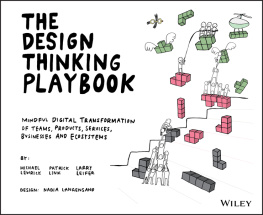Article
Chronology
All of the articles presented in this collection originally appeared in Rotman Magazine.
Back issues can be purchased at rotman.utoronto.ca/rotmanmag
Winter 2004:
Business Design
The Design of Business
by Roger Martin ()
Strategy as Design
by Jeanne Liedtka ()
Winter 2005:
The Experience Issue
The Evolution of the Design-Inspired
Enterprise
by Gabriella Lojacono and Gianfranco Zaccai ()
Fall 2005:
The Growth Issue
Embedding Design into Business
by Roger Martin ()
Winter 2006:
The Health Issue
Managing Change by Design
by Peter Coughlan and Ilya Prokopoff ()
Spring 2006:
The Creative Age
If Managers Thought Like Designers
by Jeanne Liedtka ()
Designing in Hostile Territory
by Roger Martin ()
Turning Design Thinking into Design Doing
by Heather Fraser ()
Fall 2006:
The Loyalty Issue
Loyalty By Design: Using Design to Create Fiercely Loyal Customers
by Jeremy Alexis ()
Winter 2007:
Whats Next?
Time for Design
by Jeanne Liedtka and Henry Mintzberg ()
Spring 2007:
The Risk Issue
Embracing Risk to Learn, Grow and Innovate
by Diego Rodriguez and Ryan Jacoby ()
Winter 2008:
Thinking about Thinking: How Design Offers Strategy a New Tool Kit
The Second Road of Thought:
How Design Offers Strategy a New Tool Kit
by Tony Golsby-Smith ()
Design Thinking: On its Nature and Use
by Charles Owen ()
Possibility Thinking: Lessons from Breakthrough Engineering
by Jeanne Liedtka and Robert Friedel ()
Informing Our Intuition:
Design Research for Radical Innovation
by Jane Fulton Suri ()
Spring 2008:
The All-Consuming Issue
From Plague to Paradigm: Designing Sustainable Retail Environments
by Steve Bishop and Dana Cho ()
Winter 2009:
Wicked Problems
Building Shared Understanding of Wicked Problems
by Karen Christensen and Jeff Conklin ()
Designing Systems at Scale
by Fred Dust and Ilya Prokopoff ()
Spring 2009:
Staying Power
A Survival Guide for the Age of Meaning
by Sohrab Vossoughi ()
The Empathetic Organization
by Dev Patnaik and Peter Mortensen ()
How Design Catalysts Conquer Growth Gridlock
by Jeanne Liedtka ()
Winter 2010:
Decisions, Decisions, Decisions
Mapping the Future in Uncertain Times
by Alonzo Canada ()
Decisions by Design: Stop Deciding, Start Designing
by Colin Raney and Ryan Jacoby ()
Spring 2010:
Artistry
Developing Design Sensibilities
by Jane Fulton Suri and Michael Hendrix ()
The Art of Looking
by Sarah Rottenberg and Isabel OMeara ()
Artistry: The Territory, the Map and a Compass
by Hilary Austen ()
Winter 2011:
Thinking about Thinking II
Beyond Strategic Thinking: Strategy as Experienced
by Jeanne Liedtka ()
Supporting Innovation Through Analogical Reasoning
by Arthur Markman et al ()
Unveiling the Magic of Design: The Role of Synthesis
by Jon Kolko ()
Business Design: Becoming a Bilateral Thinker
by Heather Fraser ()
Fall 2011:
Use Your Imagination
Zen and the Art of Simplicity
by Matthew May ()
Deconstructing the Design Thinker
by Sohrab Vossoughi ()
Flipping Orthodoxies: Overcoming Insidious Obstacles to Innovation
by Bansi Nagji and Helen Walters ()
Collaborative Service: How Doing Less Can Satisfy Customers More
by Heather Emerson and Ashlea Powell ()
Designing for Growth: A Tool Kit for Managers
by Jeanne Liedtka and Tim Ogilvie ()
Winter 2012:
Open
The Future of Retail: From Revenue Generator to R&D Engine
by Dana Cho and Beau Trincia ()
Embracing Openness: Designing for the Loss of Control
by Tim Leberecht ()
Spring 2012:
Wicked Problems II
From Blueprint to Genetic Code: The Merits of an Evolutionary Approach to Design
by Tim Brown ()
Mind the Gaps: The Challenges of Using Design to Scale Solutions to Wicked Problems
by Robert Fabricant ()
Observe First, Design Second: Taming the Traps of Traditional Thinking
by Matthew May ()
Fall 2012:
Hit Refresh
Hybrid Insights: Where the Quantitative Meets the Qualitative
by Johannes Seemann ()
To subscribe to Rotman Magazine:
rotman.utoronto.ca/rotmanmag
For more information on
Rotman-UTP Publishing:
utppublishing.com
Credits
p. 14: Keystone-France/Hulton Archive/Getty Images
pp. 20-25: Jeanne Liedtka, In Defense of Strategy as Design, in California Management Review vol. 42, no. 3 (Spring 2000), pp. 8-30. 2000 by the Regents of the University of California. Reprinted by permission of the University of California Press.
pp. 26-31: As originally published in the Batten Briefings distributed by the Batten Institute at the Darden School of Business.
pp. 32-37: Reprinted by permission of John Wiley and Sons.
p. 38: Garry Gay/Photographers Choice/Getty Images
pp. 38-43: Tony Golsby-Smith, The Second Road of Thought: How Design Strategy Offers a New Toolkit. Journal of Business Strategy 28:4 (2007). Emerald Group Publishing Limited all rights reserved.
p. 61: C.J. Burton/Corbis
pp. 80-85: Reprinted by permission of MIT Sloan Management Review.
p. 86: Topical Press Agency/Hulton Archive/Getty Images
p. 92: Dave King/Dorling Kindersley/Getty Images
pp. 98-103: Originally from Managing as Designing Edited by Richard Boland Jr. and Fred Collopy. Copyright 2004 by the Board of Trustees of the Leland Stanford Jr. University. All rights reserved. Used with the permission of Stanford University Press, www.sup.org.
pp. 104-109: From THE CATALYST: HOW YOU CAN BECOME AN EXTRAORDINARY GROWTH LEADER by Jeanne Liedtka, and Robert Rosen, and Robert Wiltbank, copyright 2009 by Jeanne Liedtka, Robert Rosen, and Robert Wiltbank. Used by permission of Crown Business, a division of Random House, Inc.
p. 128: FPG/Archive Photos/Getty Images
pp. 158-163: Reprinted by permission of the Publishers from Beyond Strategic Thinking: Strategy as Experienced and Embodied, in Disruptive Business by Alexander Manu (Farnham: Gower, 2010), pp. 153-169. Copyright 2010.
p. 172: Arnold Newman/Getty Images
p. 185: DEA/G. DAGLIORTI /De Agostini Picture Library/Getty Images
p. 190: Michael Dunning/Photographers Choice/Getty Images
pp. 190-195: Friedel and Liedtka, Possibility Thinking: Lessons from Breakthrough Engineering. Journal of Business Strategy 28:4 (2007). Emerald Group Publishing Limited all rights reserved.
p. 196: Tom Kelley Archive/Retrofile/Getty Images
p. 208: Hulton-Deutsch Collection/Corbis
pp. 208-213: TOOLS FOR INNOVATION by Markman et al (2009) Chp.5 Supporting Innovation by Promoting Analogical Reasoning
pp. 85-103. By permission of Oxford University Press, USA.
p. 221: Fox Photos/Hulton Archive/Getty Images
p. 238: David Malan/Photographers Choice/Getty Images
p. 250: James Worrell/Photonica/Getty Images
pp. 256-261: Reprinted by permission of Columbia University Press.
Inside Back Cover (natural wood design): Masterfile











